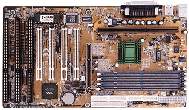Shuttle HOT-661V Apollo Pro Plus Slot-1
by Mike Andrawes on February 12, 1999 3:07 PM EST- Posted in
- Motherboards
Shuttle is a motherboard manufacturer that needs almost no introduction at AnandTech - just take a look at how many Shuttle boards we have reviewed. Their great variety of models comes from their focus on the OEM market where they have chosen to cater to just about all manufacturer's needs. As such, Shuttle has supported VIA chipsets in virtually all forms, including their latest model, the HOT-661V featuring the Apollo Pro Plus.
VIA's latest attempt to break into the Slot-1 chipset market is the Apollo Pro Plus, a chipset that is a relative new comer to the game and has earned little support so far. The original Apollo Pro did not fare well in the market place at all, and in an effort to encourage motherboard manufacturers to choose VIA, they made the Apollo Pro Plus. The plus version is functionally identical to the original Apollo Pro, but features a new pin out that makes it easier for motherboard designers to integrate the Apollo Pro Plus into existing Slot-1 motherboard designs based on the Intel i440BX. Shuttle's version is the HOT-661V.
New Anand Tech Report Card Rating 81/B-
Do not compare newer ratings to older ones, the newer ratings are much more aggressive
| CPU Interface | Slot-1 |
| Chipset | VIA Apollo Pro Plus |
| L2 Cache | N/A (on-chip) |
| Form Factor | ATX |
| Bus Speeds |
66 / 75 / 83 |
| Clock Multipliers | 2x - 5x |
| Voltages Supported | Auto Detect |
| Memory Slots | 4 168pin DIMM Slots |
| Expansion Slots | 1
AGP Slot 4 PCI Slots (4 Full Length) 3 ISA Slot (1 Shared / 3 Full Length) |
| BIOS | Award 4.51PG BIOS |
The Good
At first glance, the Shuttle HOT-661V looks virtually identical to their HOT-661P, which can be attributed to the ease of integration of the Apollo Pro Plus chipset. Through the use of a similar pin out, VIA has made it extremely easy to integrate the Apollo Pro Plus into an existing design based on an Intel chipset in an attempt to gain greater support from mainboard manufacturers. This of course allows Shuttle to base the HOT-661V on the excellent HOT-661P.
Shuttle follows the ATX specification virtually to the letter with the 661V, giving it an excellent layout. The board a standard ATX format, but is extremely short - just a bit longer than an ISA slot. Following what has become a Shuttle tradition, the 661V features a 4/3/1 (PCI/ISA/AGP) slot configuration. With the the ever increasing popularity of PCI sound cards and modems, not to mention other PCI devices, this is a somewhat old fashioned and limiting configuration. Fortunately, there are four DIMM slots support up to 1GB of SDRAM to more than adequately cover the system memory department.
Eight 1000uF capacitors are located immediately behind the Slot-1 connector with seven more located around the DIMM slots for added stability. Using the standard 66MHz and 100MHz settings, that stability proved to be quite good, with 66MHz virtually uncrashable. Overclocking, however, was another story that will be discussed later.
All HDD/FDD connectors are located where they should be, right at the front of the board, so that no cables are forced to run over the CPU and/or memory. The ATX power connector is right next to the FDD connector at the corner of the board, right where the ATX specification says it should be and helping to minimize cable clutter even further. All is not perfect with the layout, however. Shuttle was kind enough to include four fan headers, but two of them are horribly located, causing much cable clutter if you decide to use them. One of these is in between the AGP slot and the first PCI slot. The other poorly placed fan is between the first two PCI slots.
A hardware monitoring option is offered on the HOT-661V, but remember that it is an option - one that was not included on my board. It uses the increasingly popular Winbond 83781D to monitor 3 fans, 6 voltages, and up to 3 temperatures. That means one of the fans, the one between the first and second PCI slots, is not monitored. The reason for "up to 3 temperatures" is that the Winbond hardware monitor can only monitor one temperature on its own - the temperature of the Winbond chip itself. In order to monitor the other two temperatures, such as that of the CPU, the Winbond chip requires an external thermistor. Shuttle has provided an EISCA cooler connector at the front of the board that when hooked to EISCA heatsink/fan will allow the Winbond chip to measure the CPU temperature.











0 Comments
View All Comments